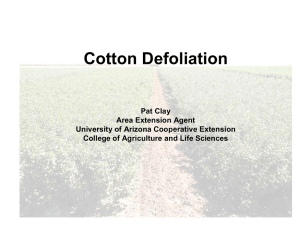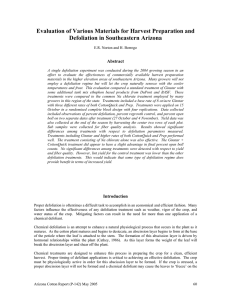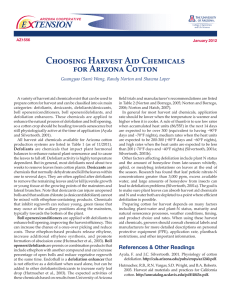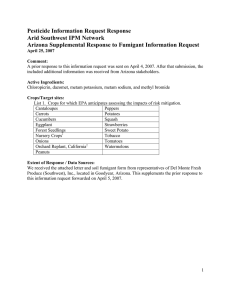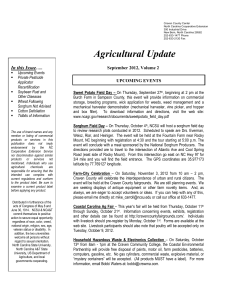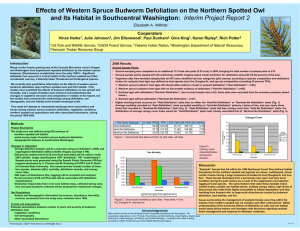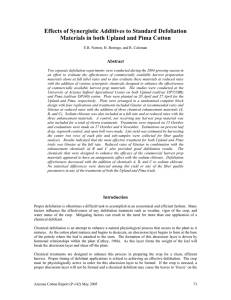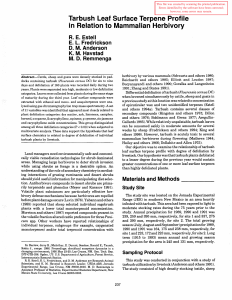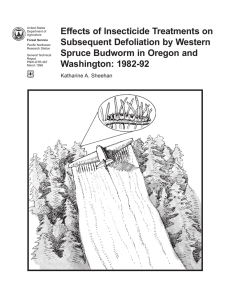Crop Management for Defoliation Cooperative Extension
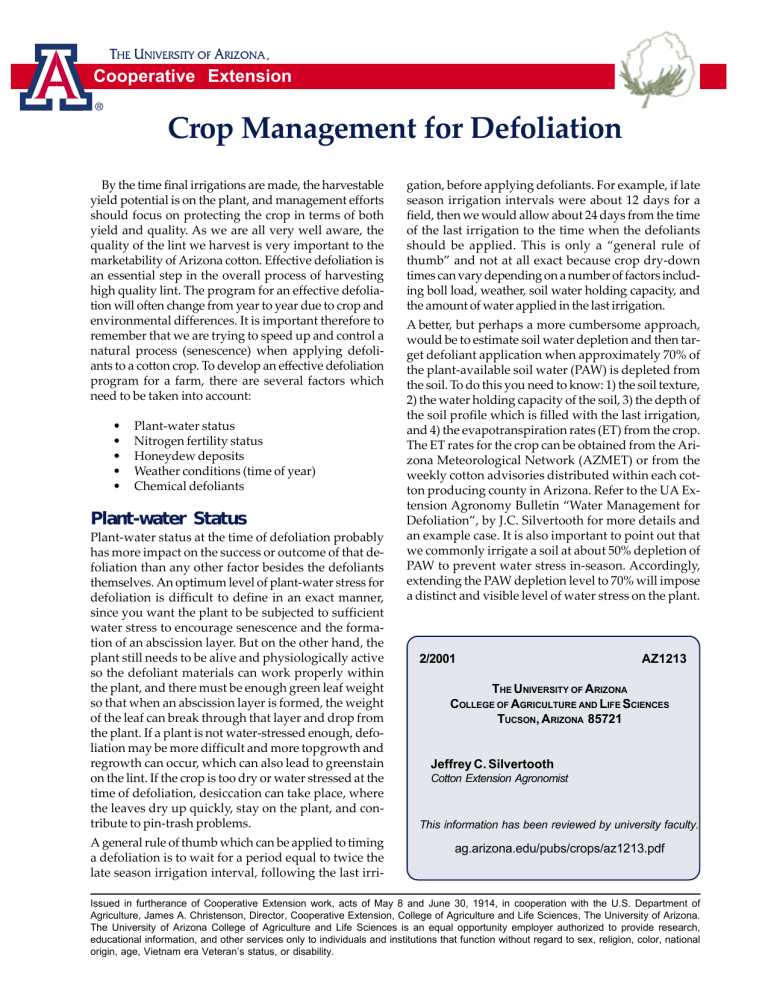
Cooperative Extension
Crop Management for Defoliation
By the time final irrigations are made, the harvestable yield potential is on the plant, and management efforts should focus on protecting the crop in terms of both yield and quality. As we are all very well aware, the quality of the lint we harvest is very important to the marketability of Arizona cotton. Effective defoliation is an essential step in the overall process of harvesting high quality lint. The program for an effective defoliation will often change from year to year due to crop and environmental differences. It is important therefore to remember that we are trying to speed up and control a natural process (senescence) when applying defoliants to a cotton crop. To develop an effective defoliation program for a farm, there are several factors which need to be taken into account:
• Plant-water status
• Nitrogen fertility status
• Honeydew deposits
• Weather conditions (time of year)
• Chemical defoliants
Plant-water Status
Plant-water status at the time of defoliation probably has more impact on the success or outcome of that defoliation than any other factor besides the defoliants themselves. An optimum level of plant-water stress for defoliation is difficult to define in an exact manner, since you want the plant to be subjected to sufficient water stress to encourage senescence and the formation of an abscission layer. But on the other hand, the plant still needs to be alive and physiologically active so the defoliant materials can work properly within the plant, and there must be enough green leaf weight so that when an abscission layer is formed, the weight of the leaf can break through that layer and drop from the plant. If a plant is not water-stressed enough, defoliation may be more difficult and more topgrowth and regrowth can occur, which can also lead to greenstain on the lint. If the crop is too dry or water stressed at the time of defoliation, desiccation can take place, where the leaves dry up quickly, stay on the plant, and contribute to pin-trash problems.
A general rule of thumb which can be applied to timing a defoliation is to wait for a period equal to twice the late season irrigation interval, following the last irrigation, before applying defoliants. For example, if late season irrigation intervals were about 12 days for a field, then we would allow about 24 days from the time of the last irrigation to the time when the defoliants should be applied. This is only a “general rule of thumb” and not at all exact because crop dry-down times can vary depending on a number of factors including boll load, weather, soil water holding capacity, and the amount of water applied in the last irrigation.
A better, but perhaps a more cumbersome approach, would be to estimate soil water depletion and then target defoliant application when approximately 70% of the plant-available soil water (PAW) is depleted from the soil. To do this you need to know: 1) the soil texture,
2) the water holding capacity of the soil, 3) the depth of the soil profile which is filled with the last irrigation, and 4) the evapotranspiration rates (ET) from the crop.
The ET rates for the crop can be obtained from the Arizona Meteorological Network (AZMET) or from the weekly cotton advisories distributed within each cotton producing county in Arizona. Refer to the UA Extension Agronomy Bulletin “Water Management for
Defoliation”, by J.C. Silvertooth for more details and an example case. It is also important to point out that we commonly irrigate a soil at about 50% depletion of
PAW to prevent water stress in-season. Accordingly, extending the PAW depletion level to 70% will impose a distinct and visible level of water stress on the plant.
2/2001 AZ1213
T
HE
U
NIVERSITY OF
A
RIZONA
C
OLLEGE OF
A
GRICULTURE AND
L
IFE
S
CIENCES
T
UCSON
, A
RIZONA
85721
Jeffrey C. Silvertooth
Cotton Extension Agronomist
This information has been reviewed by university faculty.
ag.arizona.edu/pubs/crops/az1213.pdf
Issued in furtherance of Cooperative Extension work, acts of May 8 and June 30, 1914, in cooperation with the U.S. Department of
Agriculture, James A. Christenson, Director, Cooperative Extension, College of Agriculture and Life Sciences, The University of Arizona.
The University of Arizona College of Agriculture and Life Sciences is an equal opportunity employer authorized to provide research, educational information, and other services only to individuals and institutions that function without regard to sex, religion, color, national origin, age, Vietnam era Veteran’s status, or disability.
Nitrogen Fertility Status
If a plant is high in nitrogen (N) fertility at the end of the season, the typical effect will be a delay in maturity, a more vigorous plant, and a difficult case for defoliation with a high potential for top-growth and/or regrowth problems. This is where applications of fertilizer N past peak bloom may complicate late season management, which is one reason we recommend that fertilizer N applications be completed by peak bloom.
From defoliation research across the state in recent years, we have found that petiole nitrate-N concentrations greater than 3,000 ppm can lead to defoliation problems.
Honeydew Deposits
In cases where large amounts of honeydew (exudate from insects such as whiteflies or aphids) are present on the leaves, uptake of defoliants by the plant are going to be reduced, which of course will decrease the defoliant effects. In such cases, not only will sticky lint be a problem from the honeydew, but so will defoliation efforts, both of which contribute to poor quality lint. This simply provides another incentive to control insect populations such as the whitefly, as if we don’t have enough incentive already.
Weather Conditions
As with about every other aspect of crop production, weather serves as a dominant factor. Warmer weather conditions cause the plant to be more physiologically active, which promotes and accelerates defoliant activity. Hot and dry weather patterns will also accelerate crop dry-down, which can lead to more desiccation than defoliation if defoliants are applied too late. Another major point to be considered with regard to weather, are the amounts or rates of defoliant materials needed. We have found that low rates of defoliants can be very effective when warm weather conditions prevail during the 14 day period following defoliant application. At present, we recommend low rates of defoliants if more that 300 heat units (HU) are expected
14 days following defoliant application (in general, daytime temperatures 90° F or more). Similarly, medium rates are recommended for HU accumulations in the
200 to 300 HU range, and higher rates for HU accumulations less than 200 HU (in general, daytime highs in the 70’s ° F range or less). Rates should always be based upon product label recommendations and guidelines.
Chemical Defoliants
There are many products which are labeled for cotton defoliation, most of which have been tested under field conditions in Arizona. The effectiveness of any attempt at defoliation is often attributed to (or blamed on) the chemical defoliants used. This can certainly be important, but it is also important to recognize the effect of the timing of application, current plant-water conditions, N fertility status, weather, and the combination of all of these factors. All of these ingredients contribute to the final defoliation and should be given full consideration when planning crop defoliation, or in reviewing and diagnosing successes or failures
Any products, services, or organizations that are mentioned, shown, or indirectly implied in this publication do not imply endorsement by The University of Arizona.
2 The University of Arizona Cooperative Extension
